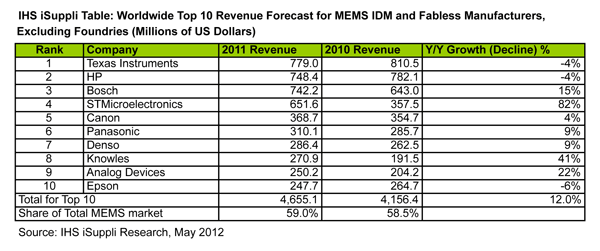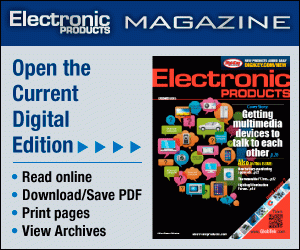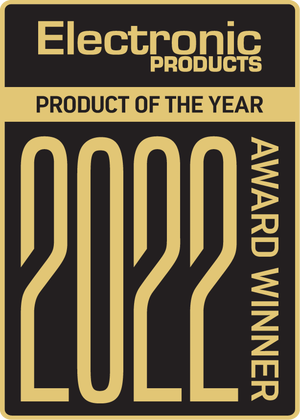DLP Technology Keeps Texas Instruments at Top of MEMS Market
El Segundo, Calif., May 8, 2012—Texas Instruments Inc. (TI) remained the world’s No. 1 microelectromechanical systems (MEMS) manufacturer in 2011, retaining top honors after fending off runner-up Hewlett Packard Co. in a bruising battle for the crown, according to an IHS iSuppli MEMS Market Brief report from information and analytics provider IHS (NYSE: IHS).
With MEMS revenue of $779.0 million, TI led a competitive field of big-name players in the overall MEMS space, whose sensors and actuators are used in a variety of industries including consumer and mobile, automotive, industrial, medical, and aerospace and defense. Together, the Top 10 MEMS players had combined revenue in 2011 of $4.7 billion, up 12 percent from $4.2 billion in 2010, as shown in the table below.

Joining TI in the Top 5, in descending order, were Hewlett-Packard, Bosch, STMicroelectronics and Canon. The top three representing TI, HP and Bosch were separated by just a small margin, heightening the sense of fierce competitiveness surrounding the space last year. And though TI and HP remained the leaders, No. 3 Bosch and fourth-ranked STM had much larger revenue jumps that could propel them to the top and lead to the dethronement of the leading incumbents very soon.
The rest of the Top 10 last year included Panasonic, Denso, Knowles Electronics, Analog Devices and Epson. Freescale Semiconductor, a former member of the group, tumbled out of the Top 10 this year and fell to No. 11.
“TI in 2011 managed to hold on to the leading position it earned in 2010 because of the continuing sales of its digital processing light (DLP) chips, which employ MEMS technology,” said Jérémie Bouchaud, director and senior principal analyst for MEMS & sensors at IHS. “TI has held the leadership spot in the MEMS business since 2010, when its DLP business rebounded because of shipments to the business and education front-projector segment. Sales are especially strong in China and India, where the DLP chip in projectors has been grabbing share away from liquid crystal displays (LCD).”
The DLP chip has been a major success story for TI, but the company has had to weather the disappearance of the rear-projection TV market in which DLP chips have been prominently featured. The erosion of the rear-projection TV market meant a 31 percent loss in MEMS revenue for TI from 2004 to 2009, until a reversal in its fortunes occurred in 2010 because of the company’s business in projectors.
TI’s MEMS revenue was down 4 percent last year from 2010 revenue of $810.5 million, with its DLP supply chain affected by the March 2011 earthquake-tsunami disaster in Japan. Nonetheless, the company managed to preserve its perch at the top for the second year in a row thanks to the business in DLP projectors, with their 3-D capability proving a bonus for the education segment in biology or physics presentations.
TI is also enjoying success in pico-projectors, even though the sector is still a relatively small part of TI’s MEMS business. The company is the top supplier of pico-projectors for both accessory and embedded projectors such as those found in the Beam handset from Samsung Electronics. All told, pico-projectors contributed to less than $50 million of TI’s MEMS revenue, but the product is expected to be one of the main growth drivers for the firm during the next five years.
Last year also saw TI introducing a MEMS temperature sensor, or thermopile, for handsets and tablets. The thermopile is placed on the printed circuit board inside the phone next to the processor, and monitors the temperature of the case of the phone or tablet. With the inclusion of the thermopile, the operation of the processor can be optimized according to the temperature of the case. Thermopiles are expected to contribute to TI’s MEMS business starting this year or by 2013.
HP struggles, but high marks for rest of Top 5
Runner-up Hewlett-Packard found itself parked again in the No. 2 position last year with revenue of $748.4 million, also down 4 percent like TI, from $782.1 million in 2010. HP has been in a continual battle with TI for the top spot and was the champion from 2005 to 2009, but last year saw pricing continue to erode for its MEMS thermal actuators used in inkjet printheads. HP had also started migrating from disposable printheads to permanent ones in 2005, resulting in lower shipments of its disposables.
The Bosch Group GmbH of Germany maintained its No. 3 ranking in the overall MEMS market with revenue of $742.2 million, but growth was up an impressive 15 percent from $643.0 million. The company’s automotive MEMS sector benefited from the rising sales of safety equipment, such as electronic stability control in which the company is among the top suppliers of inertial and pressure sensors. Bosch’s performance was also boosted by the airbag market growing rapidly in China and by pressure sensors for side airbags in the United States.
In fourth place last year was STMicroelectronics, which enjoyed the biggest jump in revenue among all MEMS manufacturers, up 82 percent to $651.6 million from $357.5 million in 2010. STMicroelectronics managed to reinforce its hold on accelerometers, the historical driver of the French-Italian maker. The company alone held 50 percent of consumer accelerometer revenue in 2011 and was the No. 1 supplier of the device to handsets, tablets, laptops and gaming. However, with the golden age for consumer accelerometers now behind, STMicroelectronics is expected to train its sights on other MEMS devices, including 3-axis gyroscopes, MEMS microphones and pressure sensors. In particular, gyroscopes last year accounted for 55 percent of MEMS revenue for STM, up from 32 percent in 2010 and less than 1 percent in 2009.
With their large revenue increases, both Bosch and STMicroelectronics could likely take over the lead very soon from TI and HP, IHS believes.
Rounding out the Top 5 was Canon with $368.7 million, up 4 percent from $354.7 million. Unlike Canon, the other three main inkjet head manufacturers saw their revenue decline in 2011; the three included HP, Epson and Lexmark.

Advertisement
Learn more about IHS iSuppli





